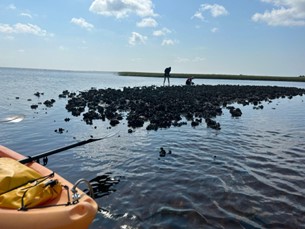President's Showcase
Erin Tilly she/her
Supervising Professor: Joshua L. Breithaupt
Erin Tilly is a fourth-year undergraduate student double majoring in Environmental Science and Biology. She has spent the past two years working in the Breithaupt Biogeochemistry lab at the Florida State University Coastal and Marine Lab studying the condition and sediment composition of intertidal oyster reefs in Franklin County, FL. During her time at FSU, Erin became a member of the Gulf Scholars program and presented her work at the 2024 ACC Meeting of the Minds and 2024 Apalachicola NERR Symposium. After completing her undergraduate education in the spring of 2025, she plans to pursue a master’s degree.
Abstract
Oysters are a keystone species that provide ecologic and economic benefits to coastal ecosystems and human communities. The Apalachicola Bay oyster population began declining in 2012, leading to a fishery closure in 2020. Causes of the decline are debated, but alterations in the timing and flow of the Apalachicola River decreased the transport of terrestrial organic matter from the floodplain to the estuary, likely altering sources and quantity of food available to the Bay’s oysters. This study surveyed intertidal reefs at 5 sites along 80 km of the coast to evaluate differences in the elemental and isotopic composition of sediment organic matter (SOM) as a proxy for oyster diet composition. Results indicated significant differences in SOM abundance, ranging from 13% in AH to 31% in EC. Mean C:N varied minimally across sites except for EC, ranging from a low of 5:1 in EC to a high 7:1 in CR. The δ13C values suggested a mostly terrigenous source in IL with a low of -23‰ and a stronger marine, salt marsh or seagrass influence at PC with a high of -17.6‰. Overall, these findings indicate that these sites do vary in SOM abundance and composition, but additional work is needed to tease apart whether this is due differences in the source of the material or post-depositional degradation processes. These results describing the composition of SOM on reefs are being compared with additional physical and biological reef characteristics to determine whether SOM differences are indicative of differences in oyster health and abundance.
Presentation Materials




